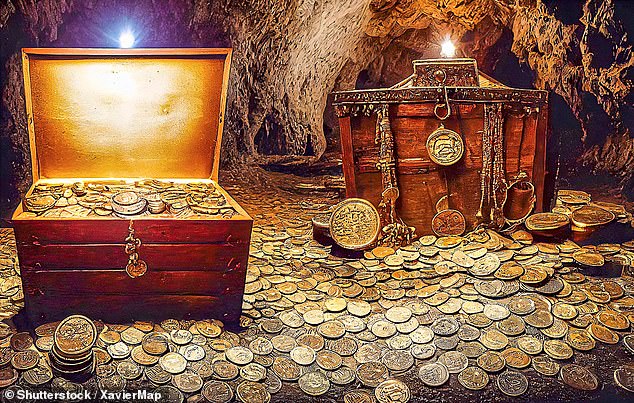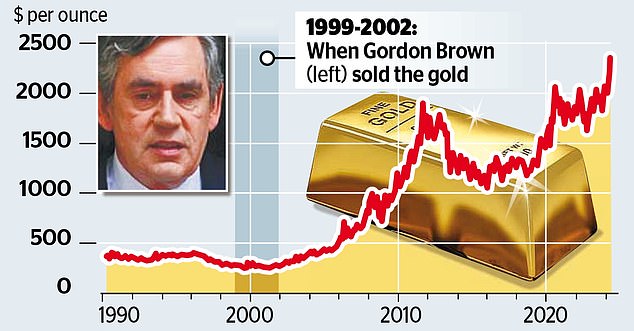Gordon Brown’s decision to sell more than half of the UK’s gold reserves cheaply 25 years ago is seen by some as the behavior of a sensible investor seeking to spread the nation’s financial risk.
As the former chancellor would protest to the International Monetary Fund in the summer of 2007 – shortly after becoming prime minister – it was a “perfectly reasonable” portfolio decision to reduce Britain’s dependence on such a fickle asset.
It was also something echoed by central banks around the world at the time.
For its critics, however, it remains one of the worst financial decisions in British political history, and one that has cost the Treasury billions in lost profits.
With the 25th anniversary of Brown’s announcement on May 7, 1999 approaching, it certainly isn’t aging well.

Brilliant: Gold investors have been on a winning streak, with prices up around 30% in the last six months.
Gold prices hit an all-time high of $2,365 an ounce yesterday as their remarkable rally continued.
The Bank of England sold 395 tonnes of gold bullion between 1999 and 2002 at an average price of $276 an ounce, totaling around $3.5 billion, which was largely invested in US Treasury securities.
Had it been sold today, it would have raised just under $33bn or £26bn, a considerable sum for a cash-strapped government.
Gold investors have been on a winning streak, with prices up about 30 percent in the last six months.
Miners extracting the material from the earth have been licking their lips, especially in Australia, home to about a fifth of all known gold deposits, the largest proportion of any country in the world.
As a highly prized and relatively rare physical asset, the precious metal is traditionally considered a “safe haven” in times of turmoil and a hedge against high inflation.
There are plenty of both right now. Although inflation has declined in many countries, including the United States and the United Kingdom, the Russian invasion of Ukraine and Israel’s war against Hamas in Gaza have created precisely the kind of chaos that makes gold particularly attractive to investors.
Meanwhile, financial markets have been counting on the US Federal Reserve to cut interest rates towards the middle of the year to boost the economy, despite strong employment data over the weekend.
Gold prices tend to rise as interest rates fall, as interest-bearing assets such as government bonds look less attractive and inflation rises.
Uncertainty over when rates will fall, to what extent they will be reduced and the impact on inflation have also contributed to pushing up gold prices.


Bad decision: The Bank of England sold 395 tons of gold bars between 1999 and 2002 for around $3.5 billion. If it had been sold today, it would have raised just under $33bn or £26bn.
On top of this, there is a US election looming in November and the prospect of Donald Trump getting a second stab at the White House.
Demand for gold has been driven by central banks – particularly the People’s Bank of China – which have been increasing their gold reserves at a time when production has been virtually flat.
Demand for gold from central banks totaled 1,037.4 metric tons last year, just below the record set the previous year, according to the World Gold Council trade association.
Meanwhile, mines produced 2,644.4 tons of gold last year, just 1 percent more than the previous year.
The result is that there is a high demand for the precious metal and there is not much more to go around.
Markets expect strong demand from central banks to continue this year, and a Chinese official reported over the weekend that it had bought gold for its reserves for the 17th consecutive month in March.
For some, however, the lasting appeal of metal makes little sense. American investor Warren Buffett summed up his misgivings during a speech he gave at Harvard University in 1998.
“Gold is mined from the ground in Africa or somewhere else,” he said.
Then we melt it down, dig another hole, bury it again, and pay people to keep watch. It has no use. Anyone watching from Mars would be scratching their heads.
For once, the Sage of Omaha, for his uncanny ability to spot market trends, seems to have missed a trick.
Russ Mould, investment director at AJ Bell, said: “Gold is durable, has a history of being money since time immemorial and is difficult and expensive to produce, so it can be seen as a store of value at a time when inflation is eroding.” the purchasing power of money in the West.’
Some links in this article may be affiliate links. If you click on them, we may earn a small commission. That helps us fund This Is Money and keep it free to use. We do not write articles to promote products. We do not allow any commercial relationship to affect our editorial independence.
